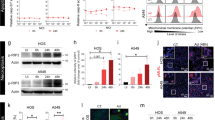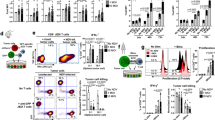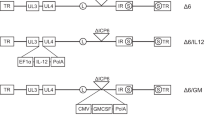Abstract
The use of dendritic cells (DCs) loaded with apoptotic tumor cells is an attractive approach to tumor vaccination in the absence of well-characterized tumor antigens. Apoptotic tumor cells are a convenient source of polyvalent tumor antigen, but may induce only weak immunization. We tested the role of replication-incompetent recombinant herpes simplex virus (HSV) d106 lacking all immediate early genes except ICP0 in the generation of apoptotic cells for tumor vaccination, using ID8-VEGF, a syngeneic mouse model of ovarian carcinoma expressing high levels of VEGF, and TC-1, a human papillomavirus (HPV) 16 E6- and E7-transformed adenocarcinoma. HSVd106 killed tumor cells by apoptosis. Tumor cells infected by HSVd106 were engulfed more avidly by immature DCs, and induced DC maturation more efficiently than tumor cells killed by ultraviolet B (UVB) radiation. HSVd106 infection induced stronger upregulation of heat shock protein (Hsp) 70 and glucose-related protein (GRP) 94 than UVB in cells undergoing apoptosis. Immunization of mice with DCs loaded with HSVd106-killed cells elicited stronger antitumor T-cell response, including tumor-reactive interferon-gamma-secreting and cytotoxic T cells, and resulted in significantly stronger delay in tumor growth than immunization with DCs loaded with UVB-killed tumor cells. Moreover, in the TC-1 model, a protective effect of vaccination (40% tumor free animals) was observed only after immunization with DCs loaded with HSVd106-killed cells. Thus, the use of replication-incompetent HSV strains lacking immediate early genes except ICP0 offers possible advantages in the preparation of whole tumor cell antigen for DC-based tumor vaccination.
This is a preview of subscription content, access via your institution
Access options
Subscribe to this journal
Receive 12 print issues and online access
$259.00 per year
only $21.58 per issue
Buy this article
- Purchase on Springer Link
- Instant access to full article PDF
Prices may be subject to local taxes which are calculated during checkout





Similar content being viewed by others
References
Steinman RM, Pope M . Exploiting dendritic cells to improve vaccine efficacy. J Clin Invest 2002; 109: 1519–1526.
Fong L, Engleman EG . Dendritic cells in cancer immunotherapy. Annu Rev Immunol 2000; 18: 245–273.
Panelli MC, Wunderlich J, Jeffries J, Wang E, MIxon A, Rosemberg SA et al. Phase 1 study in patients with metastatic melanoma of immunization with dendritic cells presenting epitopes derived from the melanoma-associated antigens MART-1 and gp100. J Immunother 2000; 23: 487–498.
Hoffmann T, Meidenbauer N, Dworacki G, Kanaya H, Whiteside TL . Generation of tumor-specific T lymphocytes by cross-priming with human dendritic cells ingesting apoptotic tumor cells. Cancer Res 2000; 60: 3542–3549.
Jenne L, Arrighi J, Jonuleit H, Saurat JH, Hauser C . Dendritic cells containing apoptotic melanoma cells prime human CD8T cells for efficient tumor lysis. Cancer Res 2000; 60: 4446–4452.
Fonteneau JF, Larsson M, Bhardwaj N . Dendritic cell–dead cell interactions: implications and relevance for immunotherapy. J Immunother 2001; 24: 294–304.
Banchereau J, Briere F, Caux C, Davoust J, Lebecque S, Liu YJ et al. Immunobiology of dendritic cells. Annu Rev Immunol 2000; 18: 767–811.
Carbone JE, Ohm DP . Immune dysfunction in cancer patients. Oncology (Huntington) 2002; 16: 11–18.
Sauter B, Albert ML, Francisco L, Larsson M, Somersan S, Bhardwaj N . Consequences of cell death: exposure to necrotic tumor cells, but not primary tissue cells or apoptotic cells, induces the maturation of immunostimulatory dendritic cells. J Exp Med 2000; 91: 423–434.
Wells AD, Malkovsky M . Heat shock proteins, tumor immunogenicity and antigen presentation: an integrated view. Immunol Today 2000; 21: 129–132.
Basu S, Binder RJ, Suto R, Anderson KM, Srivastava PK . Necrotic but not apoptotic cell death releases heat shock proteins, which deliver a partial maturation signal to dendritic cells and activate the NF-kappa B pathway. Int Immunol 2000; 12: 1539–1546.
Sinkovics JG . Viral oncolysates as human tumor vaccines. Int Rev Immunol 1991; 7: 259–287.
Coukos G, Makrigiannakis A, Kang EH, Rubin SC, Albelda SM, Molnar-Kimber KL . Oncolytic herpes simplex virus-1 lacking ICP34.5 induces p53-independent death and is efficacious against chemotherapy-resistant ovarian cancer. Clin Cancer Res 2000; 6: 3342–3353.
Aubert M, O'Toole J, Blaho JA . Induction and prevention of apoptosis in human HEp-2 cells by herpes simplex virus type 1. J Virol 1999; 73: 10359–10370.
Galvan V, Roizman B . Herpes simplex virus 1 induces and blocks apoptosis at multiple steps during infection and protects cells from exogenous inducers in a cell-type-dependent manner. Proc Natl Acad Sci USA 1998; 95: 3931–3936.
Bai L, Koopmann J, Fiola C, Fournier P, Schirrmacher P . Dendritic cells loaded with viral oncolysates potently stimulates autologous T cells from cancer patients. Int J Oncol 2002; 21: 685–694.
Mikloska Z, Danis VA, Adams S, Lloyd AR, Adrian DL, Cunningham AL . In vivo production of cytokines and beta (C–C) chemokines in human recurrent herpes simplex lesions – do herpes simplex infects keratinocytes contribute to their production? J Infect Dis 1998; 177: 827–838.
Kobelt D, Lechmann M, Steinkasserer A . The interaction between dendritic cells and herpes simplex virus-1. Curr Top Microbiol Immunol 2003; 276: 145–161.
Kruse M, Rosorius O, Kratzer F, Stelz G, Kuhnt C, Steinkaseerer et al. Mature dendritic cells infected with herpes simplex virus type 1 exhibit inhibited T-cell stimulatory capacity. J Virol 2000; 74: 7127–7136.
Salio M, Cella M, Sute M, Lanzavecchia A . Inhibition of dendritic cell maturation by herpes simplex virus. Eur J Immunol 1999; 29: 3245–3253.
Samaniego LA, Wu N, DeLuca NA . The herpes simplex virus immediate-early protein ICP0 affects transcription from the viral genome and infected-cell survival in the absence of ICP4 and ICP27. J Virol 1997; 71: 4614–4625.
Samaniego LA, Neiderhiser L, DeLuca NA . Persistence and expression of the herpes simplex virus genome in the absence of immediate-early proteins. J Virol 1998; 72: 3307–3320.
Hobbs II WE, DeLuca NA . Perturbation of cell cycle progression and cellular gene expression as a function of herpes simplex virus ICP0. J Virol 1999; 73: 8245–8255.
Jugovic P, Hill AM, Tomazin R, Ploegh H, Johnson DC . Inhibition of major histocompatibility complex class I antigen presentation in pig and primate cells by herpes simplex virus type 1 and 2 ICP47. J Virol 1998; 72: 5076–5084.
Coukos G, Makrigiannakis A, Kang EH, Caparelli D, Benjamin I, Kaiser LR et al. Use of carrier cells to deliver a replication-selective herpes simplex virus-1 mutant for the intraperitoneal therapy of epithelial ovarian cancer. Clin Cancer Res 1999; 5: 1523–1537.
Coukos G, Makrigiannakis A, Montas S, Kaiser LR, Toyozumi T, Benjamin I et al. Multi-attenuated herpes simplex virus-1 mutant G207 exerts cytotoxicity against epithelial ovarian cancer but not normal mesothelium and is suitable for intraperitoneal oncolytic therapy. Cancer Gene Ther 2000; 7: 275–283.
Blank SV, Rubin SC, Coukos G, Amin KM, Albelda SM, Molnar Kimber KL . Replication-selective herpes simplex virus-1 mutants effectively treat cervical cancer. Hum Gene Ther 2002; 13: 627–639.
Zhang L, Yang N, Garcia JR, Mohamed A, Benencia F, Rubin SC et al. Generation of a syngeneic mouse model to study the effects of vascular endothelial growth factor in ovarian carcinoma. Am J Pathol 2002; 161: 2295–2309.
Lin KY, Guarnieri FG, Staveley-O'Carroll KF, Levitsky HI, August JT, Pardoll DM et al. Treatment of established tumors with a novel vaccine that enhances major histocompatibility class II presentation of tumor antigen. Cancer Res 1996; 56: 21–26.
Ji H, Chang EY, Lin KY, Kurman RJ, Pardoll DM, Wu TC . Antigen-specific immunotherapy for murine lung metastatic tumors expressing human papillomavirus type 16 E7 oncoprotein. Int J Cancer 1998; 78: 41–45.
Powell KL, Watson DH . Some structural antigens of herpes simplex virus type 1. J Gen Virol 1975; 29: 167–178.
Roby KF, Taylor CC, Sweetwood JP, Cheng Y, Pace JL, Tawfik O . Development of a syngeneic mouse model for events related to ovarian cancer. Carcinogenesis 2000; 21: 585–591.
Lamikanra A, Pan Z, Isaacs SN, Wu T, Paterson Y . Regression of established human papillomavirus type 16 (HPV-16) immortalized tumors in vivo by vaccinia viruses expressing different forms of HPV-16 E7 correlates with enhanced CD8+ T-cell responses that are home to the tumor site. J Virol 2001; 75: 9654–9664.
Lutz MB, Kukutsch N, Ogilvie AL, Rossner S, Koch F, Romani N et al. An advanced culture method for generating large quantities of highly pure dendritic cells from mouse bone marrow. J Immunol Meth 1999; 223: 77–92.
Yang D, Chertov O, Bykovskaia SN, Chen O, Buffo MJ, Shogan J et al. Beta-defensins: linking innate and adaptive immunity through dendritic and T cell CCR6. Science 1999; 286: 420–421.
Decker T, Lohmann-Matthes ML . A quick and simple method for the quantification of lactate dehydrogenase release in measurements of cellular cytotoxicity and tumor necrosis factor (TNF) activity. J Immunol Meth 1988; 15: 61–69.
Steinman RM, Turley S, Mellman I, Inaba K . The induction of tolerance by dendritic cells that have capture apoptotic cells. J Exp Med 2000; 191: 411–416.
Kotera Y, Shimizu K, Mule JJ . Comparative analysis of necrotic and apoptotic tumor cells as a source of antigen(s) in dendritic cell-based immunization. Cancer Res 2001; 61: 8105–8109.
Wu BJ, Hurst HC, Jones NC, Morimoto RI . The E1A 13S product of adenovirus 5 activates transcription of the cellular human HSP70 gene. Mol Cell Biol 1986; 6: 2994–2999.
Sedger L, Ruby J . Heat shock response to vaccinia virus infection. J Virol 1994; 68: 4685–4689.
Colberg-Poley AM, Santomenna LD . Selective induction of chromosomal gene expression by human cytomegalovirus. Virology 1998; 166: 217–228.
Kobayashi K, Ohgitani E, Tanaka Y, Kita M, Imanishi J . Herpes simplex virus-induced expression of 70 kDa heat shock protein (HSP70) requires early protein synthesis but not viral DNA replication. Microbiol Immunol 1994; 38: 321–325.
Liu B, DeFilippo AM, Li Z . Overcoming immune tolerance to cancer by heat shock protein vaccines. Mol Cancer Ther 2002; 1: 1147–1151.
Noessner E, Gastpar R, Milani V, Brandl A, Hutzler PJ, Kuppner MC et al. Tumor derived heat shock protein 70 peptide complexes are cross presented by human dendritic cells. J Immunol 2002; 169: 5424–5432.
Todryk S, Melcher AA, Hardwick N, Linardaki E, Bateman A, Colombo MP et al. Heat shock protein 70 induced during tumor cell killing induces the cytokines and targets immature dendritic cell precursors to enhance antigen uptake. J Immunol 1999; 163: 1398–1408.
Honda K, Sakaguchi S, Nakajima C, Watanabe A, Yanai H, Matsumoto M et al. Selective contribution of IFN-alpha/beta signaling to the maturation of dendritic cells induced by double-stranded RNA or viral infection. Proc Natl Acad Sci USA 2003; 100: 10872–10877.
Luft T, Luetjens P, Hochrein H, Toy T, Masterman KA, Riskalla M et al. IFN-alpha enhances CD40 ligand-mediated activation of immature monocyte-derived dendritic cells. Int Immunol 2002; 14: 367–380.
Harle P, Sainz Jr B, Carr DJ, Halford WP . The immediate-early protein, ICP0, is essential for the resistance of herpes simplex virus to interferon-alpha/beta. Virology 2002; 293: 295–304.
Schlienger K, Chu CS, Woo EY, Rivers PM, Toll AJ, Hudson B et al. TRANCE and CD40 ligand-matured dendritic cells revealed. MHC class I-restricted T cell specific for autologous tumor in late-stage ovarian cancer patients. Clin Cancer Res 2003; 9: 1517–1527.
Coukos G, Courreges MC, Benencia F . Intraperitoneal oncolytic and in situ tumor vaccination therapy: the HSV paradigm. Curr Gene Ther 2003; 3: 113–125.
Endo T, Toda M, Watanabe M, Iizuka Y, Kubota T, Kitajima M et al. In situ cancer vaccination with a replication-conditional HSV for the treatment of liver metastasis of colon cancer. Cancer Gene Ther 2002; 9: 142–148.
Toda M, Martuza RL, Kojima H, Rabkin SD . In situ cancer vaccination: an IL-12 defective vector/replication-competent herpes simplex virus combination induces local and systemic antitumor activity. J Immunol 1998; 160: 4457–4464.
Ali SA, McLean CS, Boursnell M, Martin G, Holmes CL, Reeder S et al. Preclinical evaluation of ‘whole’ cell vaccines for prophylaxis and therapy using a disabled infectious single cycle-herpes simplex virus vector to transduce cytokine genes. Cancer Res 2000; 60: 1663–1670.
Coukos G, Rubin SC, Molnar-Kimber KL . Application of recombinant herpes simplex virus-1 (HSV-1) for the treatment of malignancies outside the central nervous system. Gene Ther Mol Biol 1999; 3: 78–89.
Toda M, Rabkin SD, Martuza RL . Treatment of human breast cancer in a brain metastatic model by G207, a replication-competent multimutated herpes simplex virus 1. Hum Gene Ther 1998; 9: 2177–2185.
Advani SJ, Sibley GS, Song PY, Hallahan DE, Kataoka Y, Roizman B et al. Enhancement of replication of genetically engineered herpes simplex viruses by ionizing radiation: a new paradigm for destruction of therapeutically intractable tumors. Gene Therapy 1998; 5: 160–165.
Toyoizumi T, Mick R, Abbas AE, Kang EH, Kaiser LR, Molnar-Kimber KL . Combined therapy with chemotherapeutic agents and herpes simplex virus type 1 ICP34.5 mutant (HSV-1716) in human non-small cell lung cancer. Hum Gene Ther 1990; 10: 3013–3029.
Pawlik TM, Nakamura H, Yoon SS, Mullen JT, Chandrasekhar S, Chiocca EA et al. Oncolysis of diffuse hepatocellular carcinoma by intravascular administration of a replication-competent, genetically engineered herpes virus. Cancer Res 2000; 60: 2790–2795.
Carew JF, Kooby DA, Halterman MW, Federoff HJ, Fong J . Selective infection and cytolysis of human head and neck squamous cell carcinoma with sparing of normal mucosa by a cytotoxic herpes simplex virus type 1 (G207). Hum Gene Ther 1999; 10: 1599–1606.
Kucharczuk JC, Randazzo B, Chang MY, Chang MY, Amin KM, Elshami AA et al. Use of a replication-restricted herpes virus to treat experimental human malignant mesothelioma. Cancer Res 1997; 57: 466–471.
Randazzo BP, Bhat MG, Kesari S, Fraser NW, Brown SM . Treatment of experimental subcutaneous human melanoma with a replication-restricted herpes simplex virus mutant. J Invest Dermatol 1997; 108: 933–937.
Kesari S, Randazzo BP, Valyi-Nagy T, Huang QS, Brown SM, MacLean AR et al. Therapy of experimental human brain tumors using a neuroattenuated herpes simplex virus mutant. Lab Invest 1995; 73: 636–648.
Zhang L, Conejo-Garcia JR, Katsaros D, Gimotti PA, Massobrio M, Regnani G et al. Intratumoral T cells, recurrence, and survival in epithelial ovarian cancer. N Engl J Med 2003; 348: 203–213.
Acknowledgements
This work was supported by a grant from the Berlex Foundation and IRG-78-002-24 grant from the American Cancer Society to the Abramson Cancer Center of the University of Pennsylvania. MCC and FB were supported by NIH Research Grant #D43 TW00671 funded by the Fogarty International Center.
Author information
Authors and Affiliations
Corresponding author
Rights and permissions
About this article
Cite this article
Courrèges, M., Benencia, F., Conejo-García, J. et al. Preparation of apoptotic tumor cells with replication-incompetent HSV augments the efficacy of dendritic cell vaccines. Cancer Gene Ther 13, 182–193 (2006). https://doi.org/10.1038/sj.cgt.7700888
Received:
Revised:
Accepted:
Published:
Issue Date:
DOI: https://doi.org/10.1038/sj.cgt.7700888
Keywords
This article is cited by
-
In Vivo Dendritic Cell Tracking Using Fluorescence Lifetime Imaging and Near-Infrared-Emissive Polymersomes
Molecular Imaging and Biology (2009)
-
Whole tumor antigen vaccination using dendritic cells: Comparison of RNA electroporation and pulsing with UV-irradiated tumor cells
Journal of Translational Medicine (2008)
-
Endothelin B receptor mediates the endothelial barrier to T cell homing to tumors and disables immune therapy
Nature Medicine (2008)



